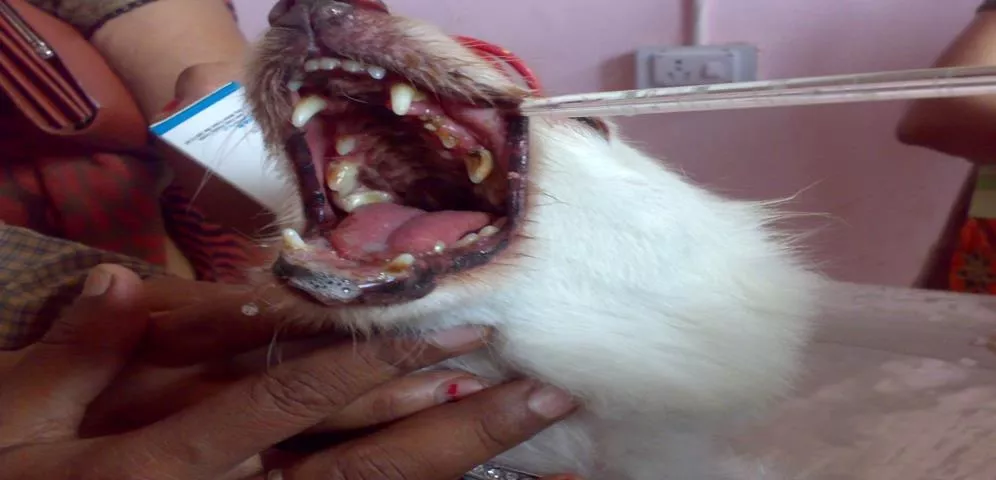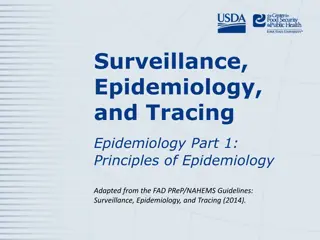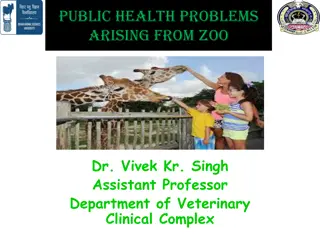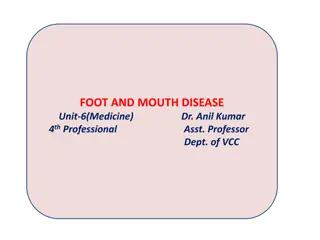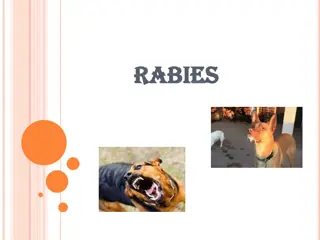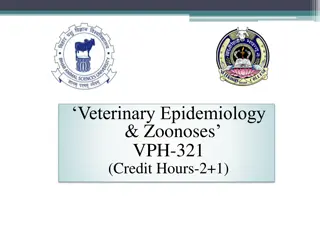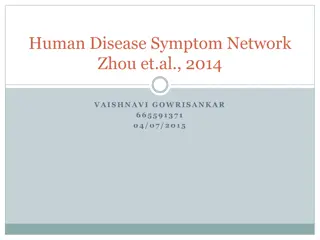Rabies: A Comprehensive Overview of the Disease
Rabies, also known as hydrophobia or mad dog disease, is a deadly viral infection that affects warm-blooded animals, including humans. This article delves into the etiology, features of the virus, and epidemiology of rabies, emphasizing its prevention and control measures to combat this fatal zoonotic disease.
Download Presentation

Please find below an Image/Link to download the presentation.
The content on the website is provided AS IS for your information and personal use only. It may not be sold, licensed, or shared on other websites without obtaining consent from the author.If you encounter any issues during the download, it is possible that the publisher has removed the file from their server.
You are allowed to download the files provided on this website for personal or commercial use, subject to the condition that they are used lawfully. All files are the property of their respective owners.
The content on the website is provided AS IS for your information and personal use only. It may not be sold, licensed, or shared on other websites without obtaining consent from the author.
E N D
Presentation Transcript
Unit 6 Dr. Arvind Kumar Das Assistant professor Department of Veterinary Medicine Bihar Veterinary College (BASU), Patna-800014.
Introduction Synonym: Hydrophobia, Lyssa, Mad dog disease, Rage, Tollwut The disease occurs as paralytic rabies, known as Derriengue Acute viral disease causes acute encephalitis. Rabies occurs in all warm blooded animals including human Rabies is one of the most deadly zoonoses. Each year, it kills nearly 60,000 people worldwide, mostly children in developing countries 1 person die from rabies every 10 min in world. Rabies 100% preventable. >95% of human deaths caused by dog-mediated rabies
ETIOLOGY Classification Family Rhabdoviridae Genus Lyssavirus (including Rabies virus) Many viruses with broad host ranges Vertebrates Invertebrates Plants Features Bullet-shaped with one flat end (75 x 180 nm), Enveloped having 10 nm spike like glycoprotein peplomers covering the surface. Image, Curtsey with google
ETIOLOGY There is a leader sequence (LDR) of approximately 50 nucleotides, followed by N, P, M, G, and L genes that encode 5 proteins. i.e. N-Nucleoprotein, P- Phosphoprotein; M-Matrix protein; G-Glycoprotein; L-large polymerase or transcriptase protein. In the nature, 7 distinct genotypes of rabies virus circulating Genotype 1 - classical rabies virus (CRV) strains, including field and laboratory fixed strains Rabies related viruses (RRVs) Genotype 2 - Lagos bat virus Genotype 3 - Mokola virus Genotype 4 - Duvenhage virus Genotypes 5 and 6 - European bat Lyssavirus 1 and 2 Genotype 7 - Australian bat Lyssavirus (ABLV) Image, Curtsey with google
Features of Virus Rhabdovirus lipid containing, single strandednon segmented nucleotide RNA of approximately 12 kb. Sensitive to lipid solvents (Soap, ether, chloroform, acetone) 45-75% ethanol, iodine preparation and quaternary ammonium compounds Relatively stable at pH between 5 & 10 Sensitive to pasteurization and UV light The nucleic acid readily inactivated by -propiolactone Virus may persist up to 18 days at inoculation site Virus travels along the nerves centripetally at a rate of roughly 3mm/hr Once disease is established it is nearly always fatal The virus can not live outside its host for more than a couple of seconds but has been found in animals as long as 48 hrs after death
Epidemiology Widely distributed throughout the world . In USA, Canada and Western Europe (rabies in dogs is controlled by vaccination), rabies is endemic in wild life Skunks, Foxes, Racoons, bats Cats are the most affected animal in USA In Asia, Latin America and Africa, rabies is endemic in dogs and wild life Vampire bats are important in the spread of rabies in cattle in South America With the exception of Antarctica, rabies is endemic on all continents. Almost 95% of cases are reported in Asia and Africa.
Rabies Transmission Hosts: All warm-blooded animals can be infected with varying susceptibility High - wolves, coyotes, foxes, dogs Intermediate - skunks, raccoons, bats Low - opossums Reptiles due to being cold blooded and birds don t get rabies Vampire bats can transmit virus for months Insectivorous and frugivorous bats may also harbour and transmit virus Young animals are more susceptible than adults Domestic animals most likely to be diagnosed with rabies : Dog > Cow > Horse/mule > sheep/goat Rodents such as mice , rats, squirrels and chipmunks may be exposed to rabies virus but are rare source to transmit. Virus occurs in saliva, nervous system, urine, lymph, milk Image, Curtsey with google
Transmission The virus is typically transmitted by bites wound or contact of infected saliva with mucous membranes (eyes, mouth, etc) The virus cannot infiltrate intact skin Saliva becomes non-infectious when it dries People have been infected by aerosol in bat caves Requires several weeks for infection to become apparent Replication in muscle in myocytes and connective tissues at site of inoculation and shed into extracellular spaces. Enters peripheral nervous system at neuromuscular junctions Spreads up the peripheral nerves to the central nervous system Entering peripheral or cranial nerves, progress to axons then enter spinal or cranial ganglia Virus replicates rapidly in ganglion and spread throughout the CNS Virus spread centrifugally by nerves throughout the body including the salivary glands Encephalitis Virus grows to high titers in the salivary glands Negri bodies appear in neuron cell bodies
Symptoms Dumb or the furious form In dumb form the animals falls into a stupor and has a peculiar staring expression Paralysis of the mastication muscles In furious form animal goes into rages, biting and slashing at any moving objects or even inanimate objects Champing of jaws, excessive salivation Paralysis may follow either the furious or dumb form Death occurs within 10 days of the 1st symptom
Symptoms Animals (domestic) Fearfulness Aggression Excessive drooling Difficulty swallowing Staggering Seizures Depression Self-mutilation Light sensitivity Animals (wildlife) Any of above Unusual behavior Nocturnal animal active during day Lose fear of humans
CLINICAL SIGNS Dog: The incubation period in natural outbreak of dog rabies averages from 3-8 weeks. But it may be as short as 10 days to as long as one year. The clinical features divided into three phases. 1) Prodromal phase: No externally visible signs are seen 2) Furious form: Mad dog syndrome, Animal bites, attack and show signs of aggression and madness, irritable, restless, nervous, deprived appetite, and often dangerous as it loses all fear of humans and bites at anything. By about 3rd day after the onset of illness the dog enters the furious stage which lasts for 3-7 days. 3) Paralytic form: Early paralysis of throat muscles. Animals shows head drooling, dropped lower jaw and salivary discharge, lasts in1-3 days. Animals show only vague CNS signs, which intensify rapidly. Image, Curtsey with google
CLINICAL SIGNS Cattle Paralytic form: Knuckling of the hind fetlocks, sagging and swaying of the hindquarters while walking, often deviation or flaccidity of the tail to one side, are common signs. Decreased sensation over the hindquarters Drooling of saliva, tenesmus, pumping of anus and followed by recumbency in later stages. Furious form: Animal alert, hypersensitive, violently attack, loud and coarse bellowing, sexual excitement and collapses suddenly. Cattle are very restless, excited and aggressive with salivation, abdominal pain, diarrhoea and rectal straining. Paralysis of hind quarters occurs followed by death in 3-6 days after the first signs of illness.
Sheep and Goats Clinically similar to cattle. Sexual excitement, violent attack, vigorous wool pulling, sudden falling and salivation are characteristic. Goats are commonly aggressive, and continuous bleating is common. Horse Muzzle tremors and pharyngeal paresis are common. In addition to these abnormal postures, kicking, biting, colic, sudden onset of lameness in one limb followed by recumbency, high stepping gait, blindness, paddling, convulsions and terminally paralysis. Pigs Tendency to attack, twitching of the nose, rapid chewing movements, excessive salivation, walk backward and terminally paralysis.
Gross pathology In majority of cases , CNS lesions are mild . Leptomeningeal congestion and mild oedema. The meninges may be cloudy . In some case uneatable objects like straw, wood, leather pieces, rubber, etc may be found in the stomach of carnivores. Histologic features Typical changes are seen only when rabid animal is allowed to die on its own The CNS lesions includes: Perivascular cuffing with lymphocytes. Vascular congestion and even perivascular haemorrhages
LESIONS (A)GROSS: no lesion. (B)MICROSCOPIC : 1.Necrosis of neuron with specific cytoplasmic inclusion body in affected nerve cell. 2.Encephalitis:It is characterised by 1)perivascular cuffing 2)neuronophagic nodules 3)Distraction of neurons. 3.Change in 1)Brain stem 2)hippocampus 3)proliferation of glial cell known as babes nodules.
Sample to be collected Live animals : Saliva, corneal/ Conjunctival smear. Dead animals The whole carcass or the severed head of the animal suspected to have died of rabies. Alternatively, the brain may be removed carefully and two portions, one in 50% glycerol saline and the other in Zenker s fixative, sent for biological test and microscopy, respectively. The brain tissue selected should include portions of hippocampus, cerebellum, cerebral cortex, and placed in 50% glycerol saline to preserve the virus. No refrigeration is required.
DIAGNOSIS It based on clinical sign , history ,symptoms, 1. FAT-fluorescent antibody test. (This test is recommended by both WHO and OIE) 2. Seller s stain negri body seen in hippocampus. 3. Histological search of negri body. 4. Serological test of Immunoperoxidase test ELISA Rapid fluorescence focus inhibition test (RFFIT) Virus neutralization test Rapid rabies enzyme immuno diagnosis test (RREID) based on the use of antinucleocapsid lgG are highly useful RT-PCR amplification technique is 1000 times more sensitive than other tests. The virus can be detected in saliva and skin biopsy samples by RT-PCR..
TREATMENT 1.No specific treatment for rabies. 2.Dogs usually die after showing clinical signs. 3.The site of bite should be washed with water or soap. Sodium bicarbonate or caustic soda may be used. 4.Wound is treated with 2% quaternary ammonium compound or tincture iodine or 40-70% alcohol. 5.Wound may also be cauterized with carbolic acid or nitric acid. 6.Antirabies serum may be applied topically or infiltrated around the wound. 7.Treatment with antirabies serum is also effective. Dose recommended is 40 I.U. per kg body weight. 8.It should be given as early as possible after exposure and in any case within five days, after which it may not be beneficial.
Vaccination of Animals Vaccine types: live or inactivated, according to the strain of rabies virus used More recently a third generation of live veterinary rabies vaccine has been developed using recombinant technology. These vaccines are used either parentrally or orally.
Vaccination of Animals Vaccine types: live or inactivated, according to the strain of rabies virus used More recently a third generation of live veterinary rabies vaccine has been developed using recombinant technology. These vaccines are used either parentrally or orally. Available for Humans, dogs, cats, ferrets, cattle and horses. Oral rabies vaccine is offered to wildlife Pre exposure vaccination- Pre exposure vaccination schedule for dogs starts at 12th week age first dose, 28 days later second dose, one year later- third dose, three years later- fourth dose. Post exposure immunization : 0, 3, 7, 14, 21, 28 days after exposure. 1. Raksha rab Indian immunological. 2. Rabigen :serum institute.
Rabigen Composition Virus titre per dose(1ml) Inactivated VP12 Rabies virus strain > 1.0 I.U Aluminum hydroxide gel (as adjuvant) 10 % v/v Thiomersal IP (as preservative) 0.01 % w/v Indication- Active immunization of Dogs, Cats, Cattle and Horses, and in principle all mammal against Rabies. As a Post Exposure Prophylaxis Image, Curtsey with google
Control (as per the WHO recommendations) Notification of suspected cases, and destruction of dogs with clinical signs and dogs bitten by a suspected rabid animal. Compulsory immunization of dogs Sterilization and vaccination of stray dogs Epidemiological Surveillance Education of Public Development of cost effective vaccine
World Rabies Day is a worldwide campaign against rabies. One person in the world dies from rabies every 10 MINUTES, equaling 60,000 each year! The disease is 100% fatal, but 100% preventable. Image, Curtsey with google








